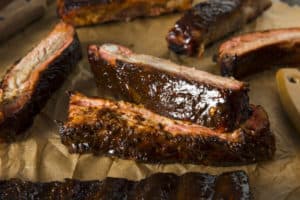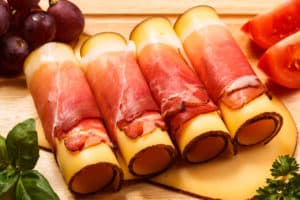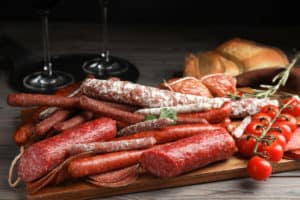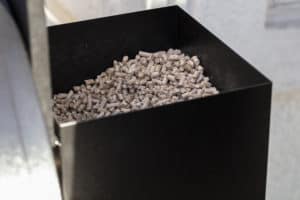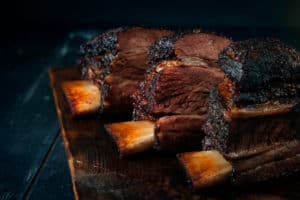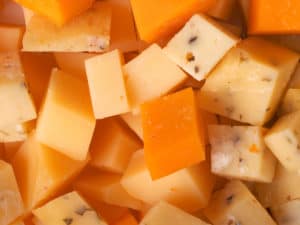How To Get The Right Blue Smoke For Meat, Every Time!
Disclosure: This post may contain affiliate links. If you use these links to buy something we may earn a commission at not additional cost to you. Learn more.
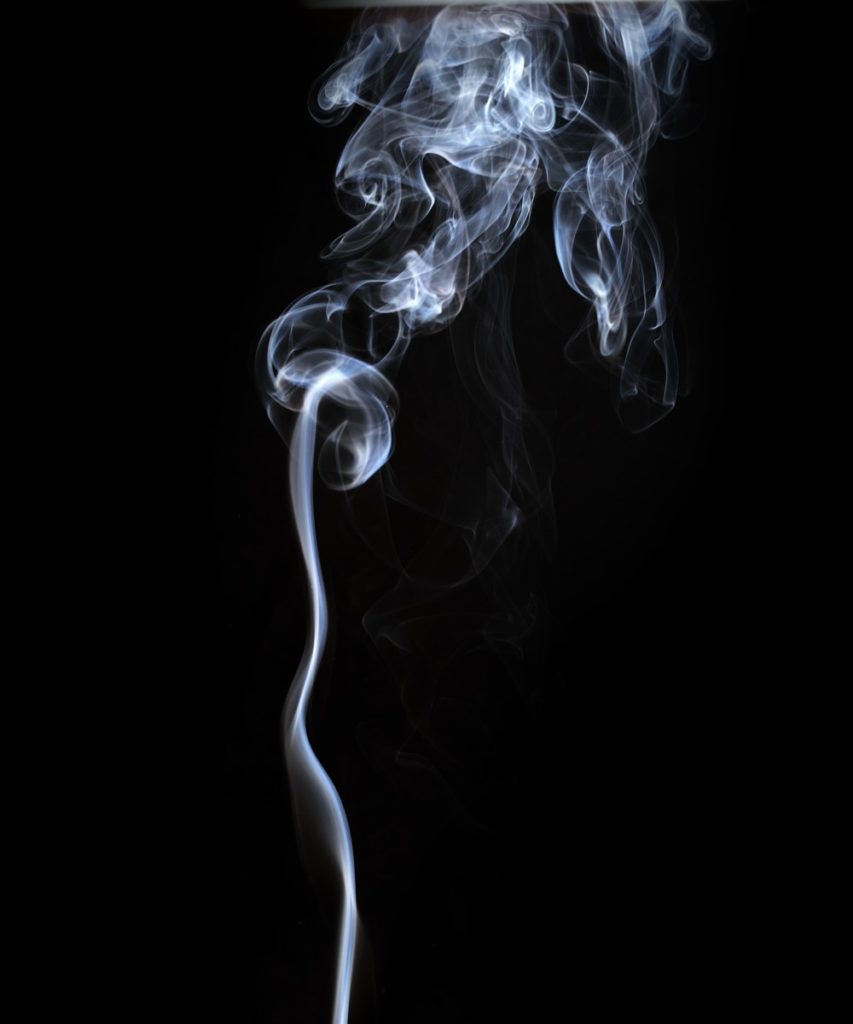
In the barbecuing world, smoke is your best friend. It flavors your meat, it brings that nice barbecuing smell to the back yard and it is fairly easy to make. Smoke is what makes barbecue, barbecue. There is actually a sweet spot within the world of smoke. There is too much smoke flavor and too little flavor, but to achieve the best smoke flavor in your meat, you will want to see clear blue smoke rising from the smoker.
To produce blue smoke you will need a clean grill, appropriate wood, and temperature and fire control. Smoke progresses throughout the rise of temperature, and blue smoke is best achieved between 650 and 750 degrees Fahrenheit. Blue smoke increases the smokey flavor of your meat.
In order to understand how to get the right blue smoke, it may be helpful to understand the stages that smoke progresses through are you burn the fuel source. It may also be helpful to know which types of woods will be most helpful and how you can gain control of your temperature and control the burn to achieve the right results.
What Smoke Is
Smoke is defined as “100s of compounds in the form of microscopic solids including char, creosote, ash, and phenols, as well as combustion gases that include carbon monoxide, carbon dioxide, nitric oxide, syringol, and liquids such as water vapor and syringol, an oil” source.
Another important definition that you will need as we go is creosote which is defined as “a thick, black, carbon-rich residues, [and] is the result of incomplete combustion of wood” source.
The Stages of Smoke & Burning Wood
From when you start the fire to when you get to the moment in which you will start cooking there is a variety of things happening to the wood as it progresses through the burning process, the smoke also changes and releases visibly different smoke as the temperature changes.
Dehydration
First, the fire and wood are in a stage known as dehydration. It is properly called this because within this stage the fuel (or wood) is not yet burning but the water within the fuel is evaporating.
This stage is taking place under 500 degrees Fahrenheit when an external source like a match of kindling is the source of heat or fire. At this point, there will be very little flame or heat produced from the fuel itself.
Pyrolysis or Gassification
As the fuel progresses above 500 degrees Fahrenheit, it goes into the next stage called pyrolysis. Here, the fuel has begun to burn but the combustion is not yet complete. Incomplete combustion happens when there is a lack of oxygen supply and water is still not completely burned off from the fuel.
During this stage, the smoke which you see contains carbon monoxide which is a poisonous gas and the reason for the bitter smell of the smoke. It is alright for meat to experience some of this smoke, but watch out during longer cooks as it will cause an odd taste in your meat.
The smoke during this stage is the billowing white, grey, or black smoke that just seems to take over everything. If you want your meat to have a nice flavor and cook slowly, it is best to wait to put it in the smoker until after this smoke has dissipated.
Combustion finally does begin in this stage, normally around 575 degrees Fahrenheit. We know that combustion is happening because the compounds within the wood are beginning to burn. It has started to release gases or liquids and a flame and smoke appear. This entire stage is happening between 500 and 700 degrees Fahrenheit.
Burning Bush
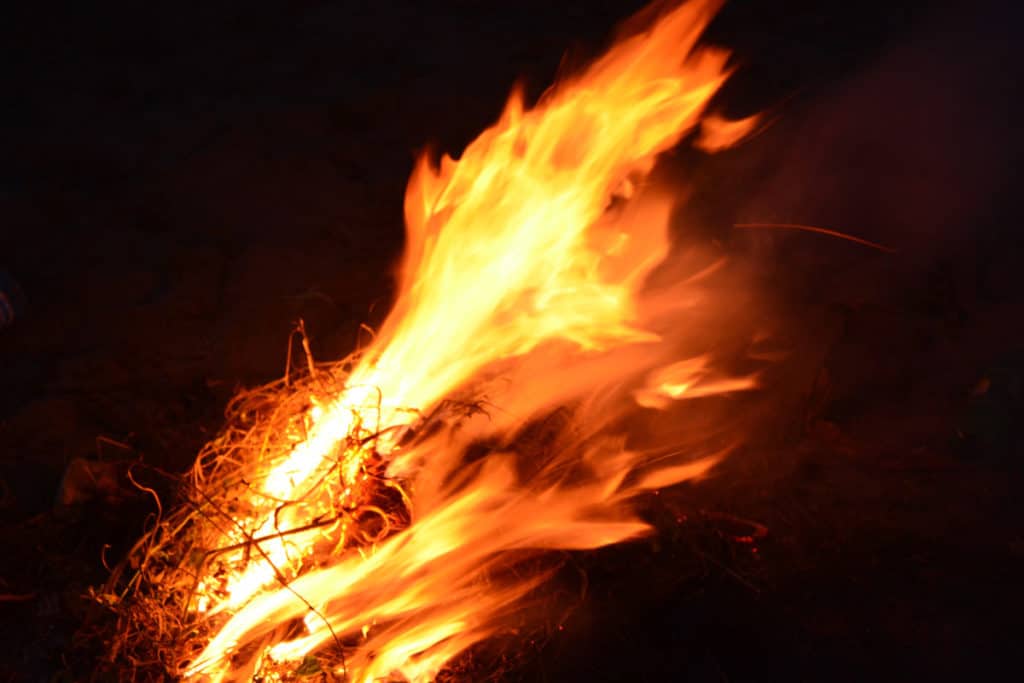
The final stage is called a variety of different things. Dr. Blonder coined this name for stage 3 because of its appeal to cooks. Source. Here is where temperatures rise from 700 up to as high as 1000 degrees Fahrenheit.
Getting that high would probably charcoal your meat, but you get the picture. The best cooking spot within this final stage is between 650 and 750 degrees. In this stage, the heat creates gases that rise up above the fuel and have the capacity to combust in gas burners this causes the flame to turn blue, while with wood or charcoal it will remain red.
Wood and charcoal tend to not supply sufficient gases to change colors but does provide it to your meat so that it gets a great flavor.
During this stage, a gas called nitric oxide forms which are essential in the creation of a smoke ring in your meat or a line of color change that you see as you cut into the slab of meat. It also creates the gases of guaiacol and syringol, which are what you can smell in the air and coin as the ‘smoke smell’. It is also the stage where you will see the pale blue smoke that we need so badly to get cooking right.
After these three stages the wood will continue to heat until it is all turned into charcoal and eventually will go out. A critical element about understanding these stages of burn is that oxygen content and temperature will cause a ripple in the stages, which is why it is important to not take the lid of the smoker off for to long. by doing this, you are allowing cold air into the smoker which cools down the burn slightly. It also provides a increase in oxygen, and then a lack of oxygen when you replace the wood back onto the fire. This messes with the stages, but can be readjusted.
Why Blue Smoke?
Most people commonly believe that to smoke meat, you will need a lot of smoke. Most of the time, lots of smoke is not needed to create that smoking flavor in your steak. As a matter of fact, those billowing clouds of smoke we mentioned above are evidence that you’re adding some poisonous chemicals to your food.
This also is where you will see creosote which we mentioned earlier. This residue leaves you with a bitter taste in your meat and some black residue on your smoker. Once you pass the stage of incomplete combustion though, you can then move on to a cleaner burn.
A cleaner burn is exhibited by the presence of clear, pale, blue smoke! Exactly what you have been looking for without all of the dangerous gases. This is just one of the reasons that you want blue smoke.
Tips for Getting Blue Smoke
Now that we know a fuel source will naturally progress through those stages, we are able to understand where at in the process that blue smoke is most likely achieved, but there are also other factors which you can work with to ensure that you are getting the right kind of smoke and ensuring that your meat has the best smoke flavor.
- Keep your grill clean: If your grill is clean then you have fewer chances of burning the soot and syrup from the smoke you did last week. It provides you with original smoke flavor and helps not to burn up the meat while the heat works to also burn off the grime of the last use. That creosote on your grill will emit the gases you don’t want around your meat when it gets hot.
- Watch your temperature: Remember that wood produces blue smoke when it gets to about 650 to 750 degree, and if it gets any hotter or cooler than that you’ll get the wrong kind of smoke. Temperature monitoring is critical.
- Use a pellet smoker tube: Pellet smoker tubes can provide an auxillery source of smoke, have a cheap fuel source, and get to the burning bush stage extremely quickly. Using a pellet smoker tube can give whatever you’re smoking more time with the top quality smoke that you want to be using.
- Let the wood burn: If your wood burns up you will go through more wood it’s true. But ultimately you’ll get more of that good blue smoke and thus a far better flavor for the meet.
- Let the coal stop smoking before you put on the meat: Coal smoke will add a bitter, kind of gross flavor to your meat. Remember that coal is just for raising the temperature and the wood should be the star of the show when it comes to smoke.
- Control oxygen: Oxygen is required for the chemical reaction that produces smoke, so make sure that plenty of oxygen is getting into the smoker. If you end up with weak embers, you can end up with your cook covered in a gross soot. If you do accidentally end up with sooty food, you should take the meat out of the smoker, clean it off, and then put it back in the smoker.
- Use dry wood: The wetter your wood is the longer it will stay in the dehydration stage. The smoke produced in that stage is not what you want for your meat, so you want to use dry wood as much as possible.
- Pay attention to size: Huge chunks of wood aren’t needed for every single cook. If you’re doing a long cook, you’ll want a piece of wood around the size of a tennis ball. For shorter cooks, use pellets or wood chips. Planning ahead will make your cooking life so much easier.
- Small, hot fire: The reason that the fire needs to be hot is self-evident; the reason it must be small is less so. A smaller fire will be be more likely to produce the right amount of smoke. A large fire might be uneven and this produce both bad white or gray smoke and good blue smoke. In order to facilitate this, keep the valve all the way open so that air will flow through easily.
- Start new logs and coal on the side: If you just throw everything onto the fire cold, you’ll end up with that same white smoke that we’re trying to avoid. Instead, start a second fire outside of your smoker and move only hot embers from that fire into the device. This will help ensure that you’re only using the best smoke.
- Practice: These kinds of skills take time to develope. The more experience you have, the more smoking power you will gain. Allow your ambition to run wild! Shoot for the stars! You are the Pit Master!
Is There Any Time When You Want To Avoid Blue Smoke?
Blue smoke is always ideal for pretty much any smoking situation. However, sometimes it isn’t realistic to expect blue smoke out of an especially short cook. In these situations, you ma want to allow your wood to let loose a little bit of that white smoke just to add flavor to your food.
If you have chosen this path, your road can be short but intense. There are a few ways to coax white smoke out of wood on a time crunch, The simplest way is to deliberately starve the wood of oxygen after it has already ignited. This will force it to smolder a large volume of thick smoke.
You might also use wood chips for fast burning smoke at a lower temperature. Especially if you’re just cooking in a regular oven and don’t want to start a full on fire this can be a pretty good option.
Pellets work for this too, and you can either use a wood chip pouch or a pellet smoker tube to hold your fuel while it burns.
Non-meat And Blue Smoke
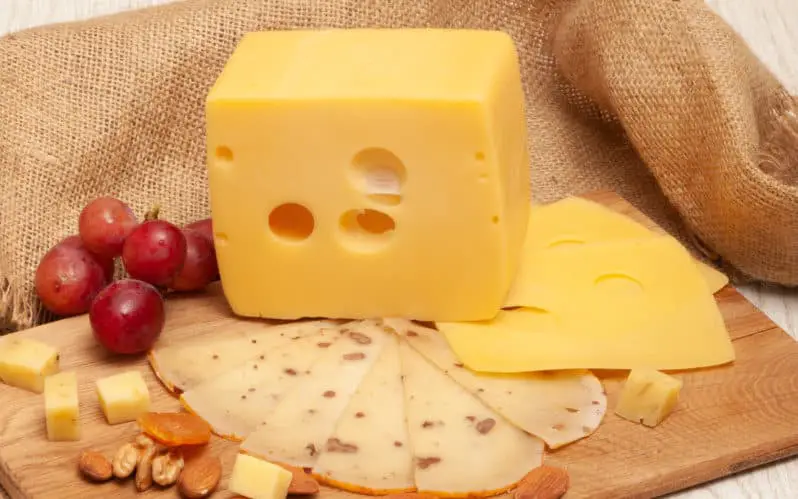
Depending on the kind of thing you’re smoking, it may not be feasible to try and get that blue smoke. Cheese, for instance, will melt if it gets too hot. This means that you often need to sacrifice smoke quality hen smoking it in order to end up with, you know, a solid block of cheese.
In this situation, you need to make sure that the cheese doesn’t get too hot and that it still gets smoked. Nuts, on the other hand, can be hot smoked just fine without melting. For nuts, you will want to make sure you reach that blue smoke level even if the amount of time they’ll spend smoking is relatively short.

